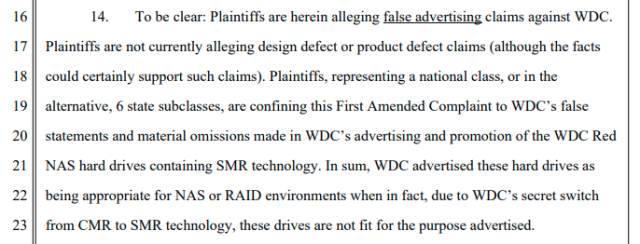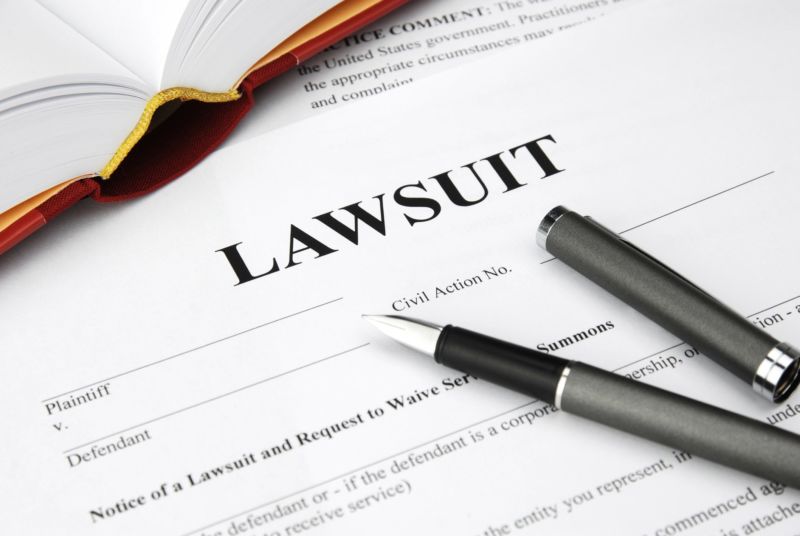Law firm Hattis & Lukacs has filed an amendment to its class-action lawsuit against Western Digital for including SMR technology in its WD Red line of NAS drives. The amendment adds five more named plaintiffs from five new states, and it includes significant additional technical detail.
If you aren’t up to date on the SMR saga, this is one article in an ongoing series. The short version: SMR—Shingled Magnetic Recording—is a relatively new hard drive recording technology that allows higher data densities. It does so by laying down overlapping tracks—like shingles on a roof—with a write head that’s wider than the read head. Unfortunately, this technology makes rewriting existing disk sectors agonizingly slow in many cases—rewriting a single 4KiB sector will generally mean needing to both read and rewrite an entire 256MiB zone.
The original American class-action suit (there’s a Canadian one as well) had a single named plaintiff, Wisconsin’s Nicholas Malone. The amendment features five new plaintiffs, each from a different state, and tells each plaintiff’s story in detail. New York plaintiff Steve Gravel’s story is particularly wince-inducing—he wasn’t just using the drives for photo and movie storage; he had an iSCSI target on his QNAP NAS, and the performance decrease when he replaced CMR drives with SMR was, as you might expect, terrible.

Jim Salter
What makes Hattis & Lukacs’ class-action suit against Western Digital interesting is that the firm isn’t just looking for money—it’s looking for a permanent injunction barring Western Digital from advertising SMR drives as appropriate for NAS devices or RAID in any way. In fact, this appears to be the major relief sought by the suit, as it also states that its plaintiffs are not currently seeking damages—merely reimbursement and attorneys’ fees.

Jim Salter
The suit leans heavily—in fact, almost exclusively—on alleged false advertisement by Western Digital. Although it makes an aggressive case about the unsuitability of the Red drives, this is basically only done to make the firm’s real case, which is that Western Digital violated the California Consumers Legal Remedies Act, False Advertising Law, Unfair Competition Law, and Consumer Protection Statute. The suit makes the case that all plaintiffs should be able to sue under California law (where Western Digital is headquartered) but makes provision to fall back under named plaintiffs’ home states as well, if and as necessary.
Should this suit succeed in getting a permanent injunction barring Western Digital’s advertisement of SMR drives as appropriate for NAS use, it will set a strong precedent for the rest of the storage industry as well.
More on Western Digital SMR from ServeTheHome
Western Digital employee Manfred Berger addressed the OpenZFS European Conference in 2015—at 13:26, he describes why drive-managed SMR is inappropriate for ZFS.
In related news, tech site ServeTheHome has followed up with additional information about both Western Digital’s own understanding of where SMR tech should and should not be used, and how vendors who resell Western Digital Red drives have responded. In our own past coverage, we speculated that perhaps WD had tested conventional RAID as seen in consumer NAS devices, but failed to test or understand ZFS.
In the video above, however, HGST engineer Manfred Berger addresses a European OpenZFS conference and describes how the drive-managed SMR—the technology used in the new Red drives—isn’t appropriate for ZFS use due to “unpredictable or reduced performance,” particularly when not in a new-out-of-box condition. Berger worked for the HGST division, not the division that designs or manufactures the Red line—but we’re still looking at a senior Western Digital hard drive engineer who clearly knew about both ZFS and drive-managed SMR’s inappropriateness for it.
ServeTheHome also points out that both Synology and ixSystems now list the SMR-equipped Red drives as incompatible with their storage appliances—and it reports that neither vendor knew ahead of time that Western Digital had introduced SMR into the Red line, leaving them to discover and react for themselves.
